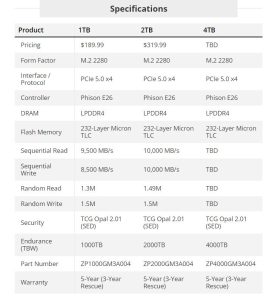Situatie
The Seagate FireCuda 540 is a fast, reliable PCIe 5.0 NVMe SSD that sets itself apart with an excellent warranty. The FireCuda’s performance is also good to excellent across the board, including in sustained workloads, which helps gear this drive for future DirectStorage game titles. It requires a PCIe 5.0-capable motherboard to take full advantage, particularly one with built-in M.2 cooling as the drive arrives bare, and pricing is also on the high end. Seagate’s attention to detail on this drive makes it a good fit for workstations, too, if you can apply your own cooling.
The initial instinct is to compare the FireCuda 540 to the Corsair MP700, a drive that shares the same hardware and also goes with the bare-drive approach. The E26’s reference heatsink, used on the Inland TD510, comes with a small fan for active cooling that’s annoying to power, noisy, and generally useless, so doing away with that is a good plan. It also makes sense to let the user decide how to cool the drive, as matching aesthetics is important with high-end machines. Having a different option, as does the Crucial T700 and Gigabyte Aorus 10000, is viable, but Seagate wanted something simple with this drive.
In my opinion, that works in Seagate’s favor. The three-year data recovery service is an excellent addition that sets it apart from the MP700. The TD510 has an extra year of warranty, but the FireCuda 540 compensates with a higher TBW endurance rating. This drive avoids risk by using the standard pSLC caching configuration, but attention is also paid to flash quality, including mitigating the possibility of counterfeit hardware. It manages to differentiate itself in a challenging space by focusing on what Seagate does right, and the fingerprints on it suggest the company’s experience in enterprise played a role.
However, these benefits come at a cost. The recovery service and higher TBW come with an elevated price tag. The TBW rating, in particular, may seem outlandishly high, but FireCuda drives historically have been excellent for write caching. The conservative pSLC cache design helps with that type of workload, too. The drive also supports hardware encryption which is often lacking in consumer products. Overall, these deviations help separate the FireCuda 540 sufficiently from the pack, but you have to judge whether or not it’s worth the price premium to get an added bit of security.




Leave A Comment?